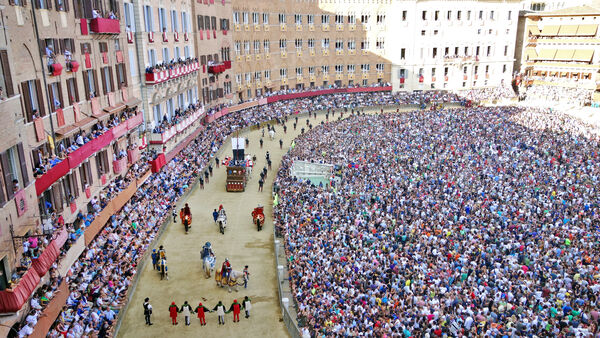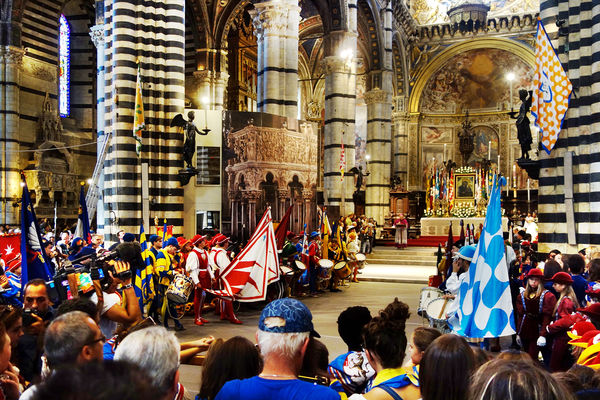Siena’s Palio: 500 Years of History in 90 Seconds
By Rick Steves


In the gorgeously preserved Tuscan hill town of Siena, the Middle Ages seem to survive in the architecture and in the civic spirit. The city is known both for its pride and for its independent attitude. And twice a year, that spirit shows itself in a crazy horse race, as it has for five centuries.
That world-famous race, the Palio di Siena, takes place twice every summer — on July 2 and August 16 — when the city's residents hurl themselves into the traditional revelry of the event with abandon.
As my friend Roberto explained when I visited to see a race, "For the Sienese, here's one's life story: You're born…there's the Palio…and then you can die."
Siena is divided into 17 neighborhoods, or contrade, of which 10 are selected by a drawing to vie for the coveted Palio banner — and all-important bragging rights. Each competing contrada's horse is chosen randomly by lottery. The neighborhood then adopts it, showering it with love, washing and grooming it, and keeping it in a five-star stable. The contrade — each with its own parish church, fountain, and square — are staunch rivals. Each contrada is represented by a mascot (porcupine, unicorn, she-wolf, and so on) and a distinctive flag. Its colors are worn and flown all year long, but omnipresent as the race nears.
While the race itself lasts just 90 seconds, it's preceded by days of festivities. As the big day approaches, processions break out across the city, including one in which the famed and treasured Palio banner — featuring the Virgin Mary, to whom the race is dedicated — is held high as it's paraded to the cathedral. Locals belt out passionate good-luck choruses. With the waving flags and pounding drums, it all hearkens back to medieval times, when these rituals boosted morale before battle.
The day before the race, I joined a crowd in the main square, Il Campo, to see the jockeys — mostly hired hands from out of town — get to know their horses in a practice run called the "charge of the carabinieri." At midnight, the streets were filled with eating, drinking, singing, and camaraderie, as neighborhoods gathered to pump themselves up.
On race day, bets are placed on which contrada will win — and lose. Despite the shady behind-the-scenes dealings, the horses are taken into their contrada's church to be blessed. "Go and return victorious," says the priest. It's considered a sign of luck if a horse leaves droppings in the church.
Meanwhile, Il Campo is converted into a racetrack. Dirt is brought in and packed down to create the surface, while mattresses pad the walls of surrounding buildings. The most treacherous spots are the sharp corners, where many a rider has bitten the dust.
The entire city of Siena packs into Il Campo. Bleacher and balcony seats are expensive, but it's free to join the masses in the square. The well-connected get to watch from the comfort of an apartment window. During my visit, Roberto's friend Franco shared his apartment overlooking the race course — and we enjoyed the best seats in town. From this vantage point, we watched as the square filled, with pageantry unfolding, flags waving, and excitement building.
Finally, it was time. A cart pulled by oxen carried the Palio banner into the arena. The crowd went wild. As the starting places were announced, 10 snorting horses and their nervous riders lined up to await the start. Silence took over. And then…
They're off! Once the rope drops, there's one basic rule: There are no rules. The jockeys ride bareback while spectators go berserk. Life stops for these frantic three laps. Up in the apartment, Roberto and Franco held their breath…
And then, it was over. The winner: Lupa, the she-wolf district! We zipped out into the street to join the ecstatic mobs coursing toward the cathedral. I'll never forget the crush and the tribal energy. Just standing in the street while celebrants surged by is a memory I'll long cherish. The happy "Lupa-Lupa-Lupa!" horde thundered by, weeping with joy. At the cathedral, the crowd packed in, and the winning contrada received the beloved banner. They were champions — until the next race.
This particular race I witnessed, in August 2016, was historic: For the first time in over a century, the same contrada won both the July and the August races (and Lupa had gone 27 years without a win). Seeing euphoria overcome members of the winning contrada reminded me that it's impossible for a tourist to really understand what this ritual race means to the people of Siena.
Carrying their coveted Palio banner high and hoisting their jockey to their shoulders, the Lupa contingent tumbled out of the cathedral and back into the streets, where the celebration continued into the wee hours — 500 years of proud tradition, still going strong.

